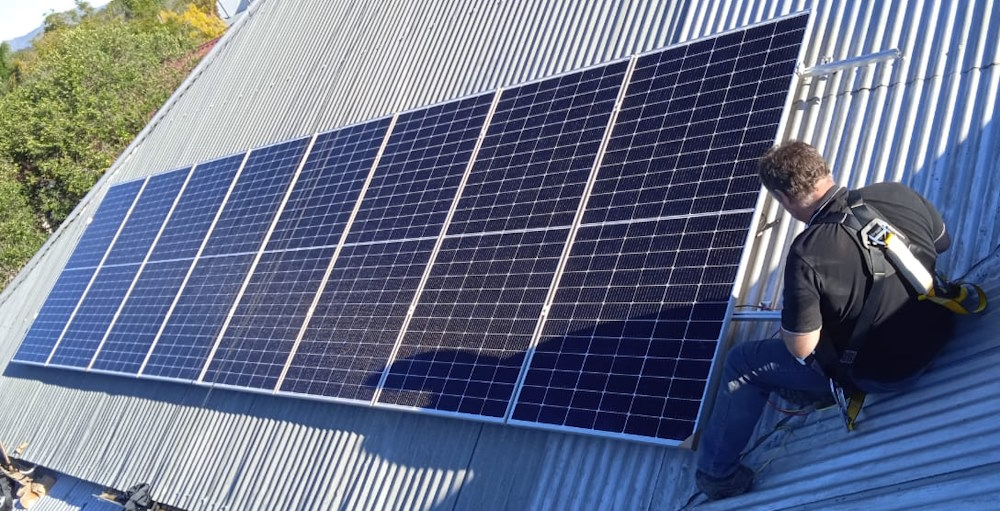Introduction
In an era where environmental sustainability and renewable energy are gaining more attention than ever, solar panels have emerged as a beacon of hope for a cleaner and more sustainable future. These sleek, shiny panels adorn rooftops and fields, silently converting sunlight into electricity. But how do solar panels work, turning sunlight into a source of clean, green energy? Let’s dive into the fascinating world of photovoltaics to uncover the secrets behind this remarkable technology.
Solar panels, often referred to as PV panels, operate by harnessing the power of sunlight to generate electricity. When sunlight strikes the surface of these panels, it initiates a process in which the photovoltaic cells within the panels absorb the solar energy and release electrons. This release of electrons creates an electrical charge within the PV panels, transforming sunlight into direct current (DC) electricity. To make this electricity usable in homes and businesses, an electrical panel comes into play. The DC electricity generated by the solar panels is then sent to an inverter, which converts it into alternating current (AC) electricity, the type of electricity commonly used in households. This AC electricity can be utilized to power various appliances and is either consumed immediately or fed back into the grid, thus reducing energy costs and contributing to a more sustainable energy landscape.
Furthermore, solar panels often produce more electrical energy than is immediately consumed. To ensure that this excess energy doesn’t go to waste, a net meter is commonly used. This device measures both the electricity you consume from the grid and the surplus electricity your solar panels generate. When your solar panels produce more electricity than you need, the excess is sent back to the grid, and your net meter records this surplus. This not only helps you save money on your energy bills but also contributes to a more sustainable and environmentally friendly energy system.
The Science Behind Solar Panels:
Solar panels, often powered by photovoltaic cells, are at the forefront of renewable energy solutions. These remarkable solar technologies operate on a basic principle: they harness the energy of the sun to create electrical power. Photovoltaic cells within the panels are comprised of semiconductor materials that absorb photons from sunlight, knocking electrons loose from their atoms and generating a flow of electricity. This process, known as the photovoltaic effect, creates an electrical current within the cells. However, there are other solar technologies like concentrated solar power (CSP), which utilize mirrors or lenses to focus sunlight onto a central point, typically heating a fluid to produce steam and drive a turbine, ultimately generating electricity. These diverse solar technologies collectively contribute to a cleaner, more sustainable energy future.
At the heart of every solar panel is a simple yet revolutionary concept known as the photovoltaic effect.
Here’s a breakdown of the process:
1 Absorption of Sunlight:
- Solar panels are composed of numerous individual solar cells, typically made from silicon, a semiconductor material.
- When sunlight, which is a stream of tiny packets of energy called photons, strikes these solar cells, something remarkable happens. The solar cells absorb the incoming photons.
2 Generation of Electron-Hole Pairs
- The energy from absorbed photons is transferred to electrons in the silicon atoms, causing some of them to break free from their positions within the atoms.
- This liberation of electrons creates what’s known as electron-hole pairs, essentially creating free-moving electrons and positively charged “holes.”
3 Flow of Electric Current:
- With the electron-hole pairs in place, a flow of electric current can be established.
- However, it’s not a free-for-all; an electric field within the solar cell directs the movement of these free electrons.
4 Capturing Electric Current:
- The solar cell incorporates conductive metal contacts on its surface.
- These contacts capture the electric current generated by the movement of electrons and transfer it out of the cell as usable electricity.
5 Conversion to Usable Power:
- The electricity generated by the solar cell is in the form of direct current (DC), which is then ready to power various electrical devices or be stored in batteries.
- In some cases, especially for homes and businesses, the DC electricity is converted into alternating current (AC) using an inverter. AC is the standard form of electricity used in most buildings
.
Solar Panels in Action:
Now that we understand the basic science behind solar panels and how do solar panels work, let’s explore how they operate in real-world scenarios:
1 Sunlight Absorption
Solar panels are strategically placed to capture maximum sunlight exposure. This often involves mounting them on rooftops or in solar farms, where they can receive uninterrupted sunlight throughout the day.
2 Energy Conversion
As sunlight strikes the solar panels, the photovoltaic effect begins, converting solar energy into electrical energy. This electricity can be immediately used or stored for later use.
3 Grid-Tied Systems
In grid-tied solar systems, surplus electricity can be fed back into the grid, allowing homeowners to earn credits or even generate revenue from excess power production.
4 Off-Grid Systems
In remote areas or during power outages, solar panels can provide a reliable source of electricity when combined with energy storage solutions like batteries.
Conclusion:
Solar panels are not just marvels of modern science; they are tangible symbols of a sustainable future. By harnessing the power of the sun, they generate clean, renewable energy while reducing our dependence on fossil fuels and mitigating the impact of climate change. Understanding how solar panels work empowers us to embrace this transformative technology and take steps toward a more sustainable and environmentally conscious future. As the sun continues to shine, solar panels will play an increasingly vital role in powering our world.

